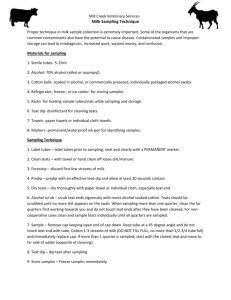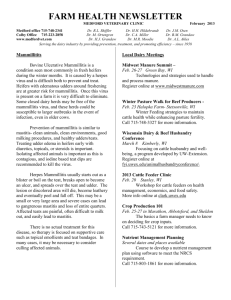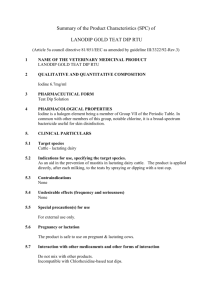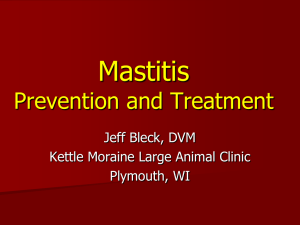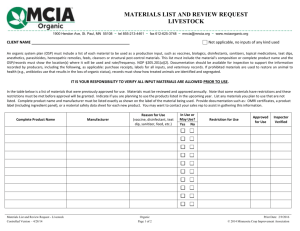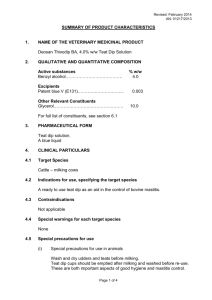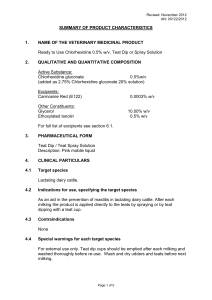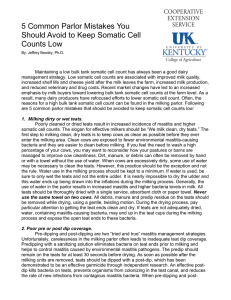Proper prepping of cows for milking helps to improve milk... especially during hot, rainy weather
advertisement
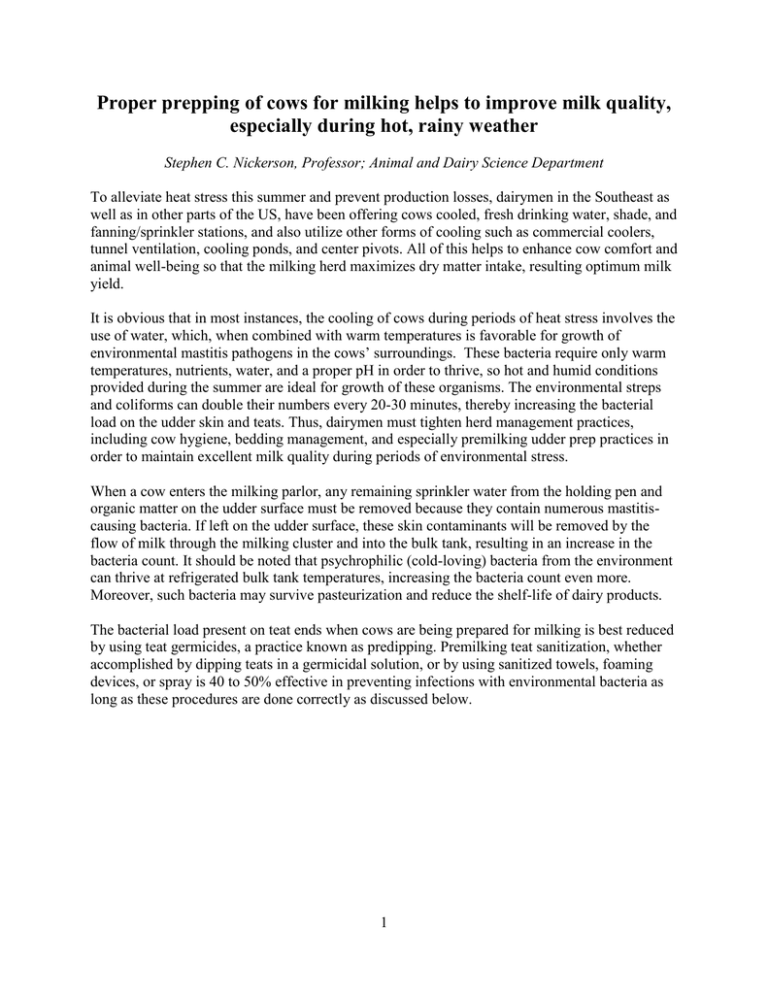
Proper prepping of cows for milking helps to improve milk quality, especially during hot, rainy weather Stephen C. Nickerson, Professor; Animal and Dairy Science Department To alleviate heat stress this summer and prevent production losses, dairymen in the Southeast as well as in other parts of the US, have been offering cows cooled, fresh drinking water, shade, and fanning/sprinkler stations, and also utilize other forms of cooling such as commercial coolers, tunnel ventilation, cooling ponds, and center pivots. All of this helps to enhance cow comfort and animal well-being so that the milking herd maximizes dry matter intake, resulting optimum milk yield. It is obvious that in most instances, the cooling of cows during periods of heat stress involves the use of water, which, when combined with warm temperatures is favorable for growth of environmental mastitis pathogens in the cows’ surroundings. These bacteria require only warm temperatures, nutrients, water, and a proper pH in order to thrive, so hot and humid conditions provided during the summer are ideal for growth of these organisms. The environmental streps and coliforms can double their numbers every 20-30 minutes, thereby increasing the bacterial load on the udder skin and teats. Thus, dairymen must tighten herd management practices, including cow hygiene, bedding management, and especially premilking udder prep practices in order to maintain excellent milk quality during periods of environmental stress. When a cow enters the milking parlor, any remaining sprinkler water from the holding pen and organic matter on the udder surface must be removed because they contain numerous mastitiscausing bacteria. If left on the udder surface, these skin contaminants will be removed by the flow of milk through the milking cluster and into the bulk tank, resulting in an increase in the bacteria count. It should be noted that psychrophilic (cold-loving) bacteria from the environment can thrive at refrigerated bulk tank temperatures, increasing the bacteria count even more. Moreover, such bacteria may survive pasteurization and reduce the shelf-life of dairy products. The bacterial load present on teat ends when cows are being prepared for milking is best reduced by using teat germicides, a practice known as predipping. Premilking teat sanitization, whether accomplished by dipping teats in a germicidal solution, or by using sanitized towels, foaming devices, or spray is 40 to 50% effective in preventing infections with environmental bacteria as long as these procedures are done correctly as discussed below. 1 Udder prep procedure: 1 4 3 2 5 Figure 4. When a cow enters the milking stall, the usual recommendation is to fore-strip each quarter using the gloved hand (1). This is followed by predipping and allowing the germicide to remain in contact with the teat skin for 30 seconds (2). Next, the germicide and any remaining organic materials are removed using single service paper or cloth towels (3). The teat orifice should then be examined to ensure it is clean (4), and then the milking unit is attached (5). Forestripping is important because it flushes environmental bacteria from the teat orifice, stimulates milk letdown, and allows the machine operator to observe milk for any abnormalities. Milkers’ hands can transmit bacteria to and among cows, and wearing gloves reduces this transfer because bacteria do not adhere to the rubber/plastic surfaces of gloves as strongly as they do to human skin. When a milker touches a teat contaminated with bacteria, these bacteria are transferred to the milker’s hands, and when the milker touches the teats of another cow, these bacteria on his hands are transferred to those teats, which can result in new infections. Wearing gloves minimizes this potential microbial transfer. Although predipping is sometimes performed first followed by forestripping, the sequence of forestripping followed by predipping is preferred because by forestripping first, bacteria already present on the teat skin as well as from milkers’ hands via forestripping are subsequently killed by the germicide in the predip. The 30-second contact time is important because the active germicidal component, e.g., iodine or chlorine, needs this amount of time to penetrate the nooks 2 and crannies of the teat skin to contact and kill the streptococci, coliforms, and staphylococci that are colonizing these areas. The practice of premilking teat sanitization has been shown to be 40 to 50% effective in preventing new infections caused by E. coli, Klebsiella, Enterobacter, Citrobacter, Serratia, Strep. uberis, Strep. dysgalactiae, and Staph. aureus. When predipping, it is important to cover the entire surface of the teat that will be in contact with the teat cup liner, thereby killing more mastitis-causing bacteria. After predipping and allowing the 30-second contact time, the germicide and any remaining organic materials are removed using single service paper or cloth towels. The teat orifice should then be examined to ensure it is clean, and then the milking unit is attached. During milking, teat surfaces become contaminated with mastitis-causing bacteria, both from the previous cow that may have had mastitis as well as from the cow being milked. This results in bacteria being deposited in the milk film present on the teat cup liner and teat surface. After the milking unit is removed, the film of milk remaining on the teat surface can support the growth of these organisms. However, postmilking teat disinfection (postdipping) replaces this milk film with a germicide that kills the majority of these bacteria, and this process has been shown to be 50 to 95% effective in preventing new intramammary infections. As with predipping, when applying a postdip, it is important to cover the entire surface of the teat that was in contact with the contaminated teat cup liner. When the cow leaves the milking parlor, it is important to offer feed so that that she remains standing for approximately 1 h and does not lay down in mud and manure. During this time, her teat canals remain dilated from the machine milking process, and this provides easy access to the interior of the gland by environmental bacteria. After 1 h, the teat sphincter muscle has contracted around the teat canal keratin and formed a seal against bacterial penetration. 3
